Business Resources Report: Tesco PLC Analysis of Resources and Finance
VerifiedAdded on 2020/01/21
|9
|2960
|57
Report
AI Summary
This report provides a comprehensive analysis of Tesco PLC's business resources, focusing on various aspects of its operations. It begins by examining recruitment documentation and the key employability, personal, and communication skills required for a team leader role within the company. The report then delves into the physical and technological resources essential for Tesco's operations, followed by an exploration of the internal and external sources of finance available to the business. Furthermore, the report includes a description of the key elements of Tesco's trading, including its balance sheet, and illustrates the use of budgeting for financial control. Finally, it provides an overview of the company's financial state, offering insights into its performance and strategies. The report utilizes information from various sources to provide a detailed understanding of Tesco PLC's business practices.
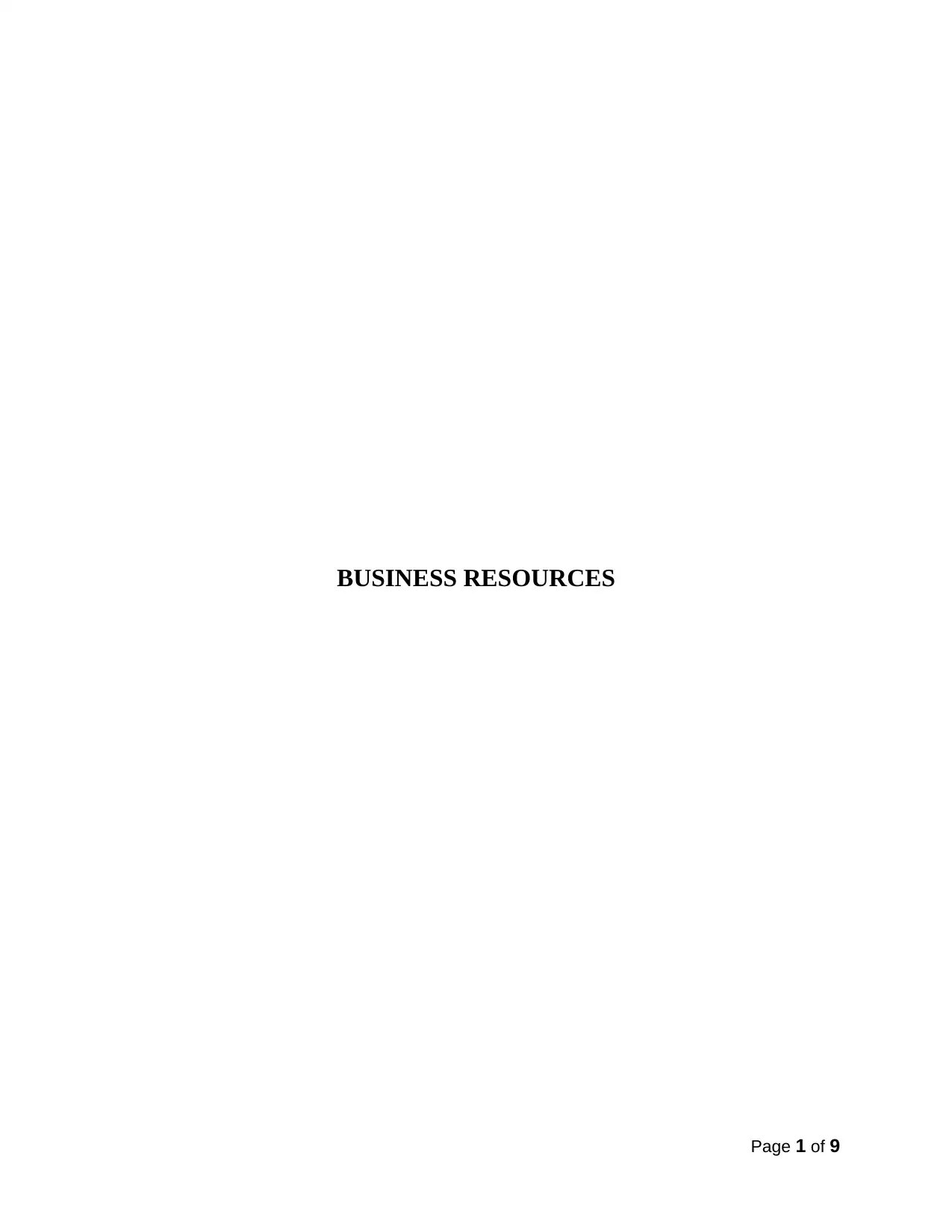
BUSINESS RESOURCES
Page 1 of 9
Page 1 of 9
Paraphrase This Document
Need a fresh take? Get an instant paraphrase of this document with our AI Paraphraser

Table of Contents
Introduction......................................................................................................................................3
Task 1...............................................................................................................................................3
The description on the recruitment documentation used in a selected organisation and describing
the main employability, personal and communication skills required when applying for a
specified job role. (P1; P2)..............................................................................................................3
Task 2...............................................................................................................................................4
P3. Description on the main physical and technological resources required for the operation of
the selected organisation..................................................................................................................4
Task 3...............................................................................................................................................6
P4. The range of internal and external sources of finance available to the selected business.........6
P5. Describing the key elements of the trading for the company including its balance sheet.........7
P6. Illustrating the use of the budget in terms of the financial control of the company..................7
P7. Illustrating the financial state of the company..........................................................................8
Conclusion.......................................................................................................................................8
References........................................................................................................................................9
Page 2 of 9
Introduction......................................................................................................................................3
Task 1...............................................................................................................................................3
The description on the recruitment documentation used in a selected organisation and describing
the main employability, personal and communication skills required when applying for a
specified job role. (P1; P2)..............................................................................................................3
Task 2...............................................................................................................................................4
P3. Description on the main physical and technological resources required for the operation of
the selected organisation..................................................................................................................4
Task 3...............................................................................................................................................6
P4. The range of internal and external sources of finance available to the selected business.........6
P5. Describing the key elements of the trading for the company including its balance sheet.........7
P6. Illustrating the use of the budget in terms of the financial control of the company..................7
P7. Illustrating the financial state of the company..........................................................................8
Conclusion.......................................................................................................................................8
References........................................................................................................................................9
Page 2 of 9
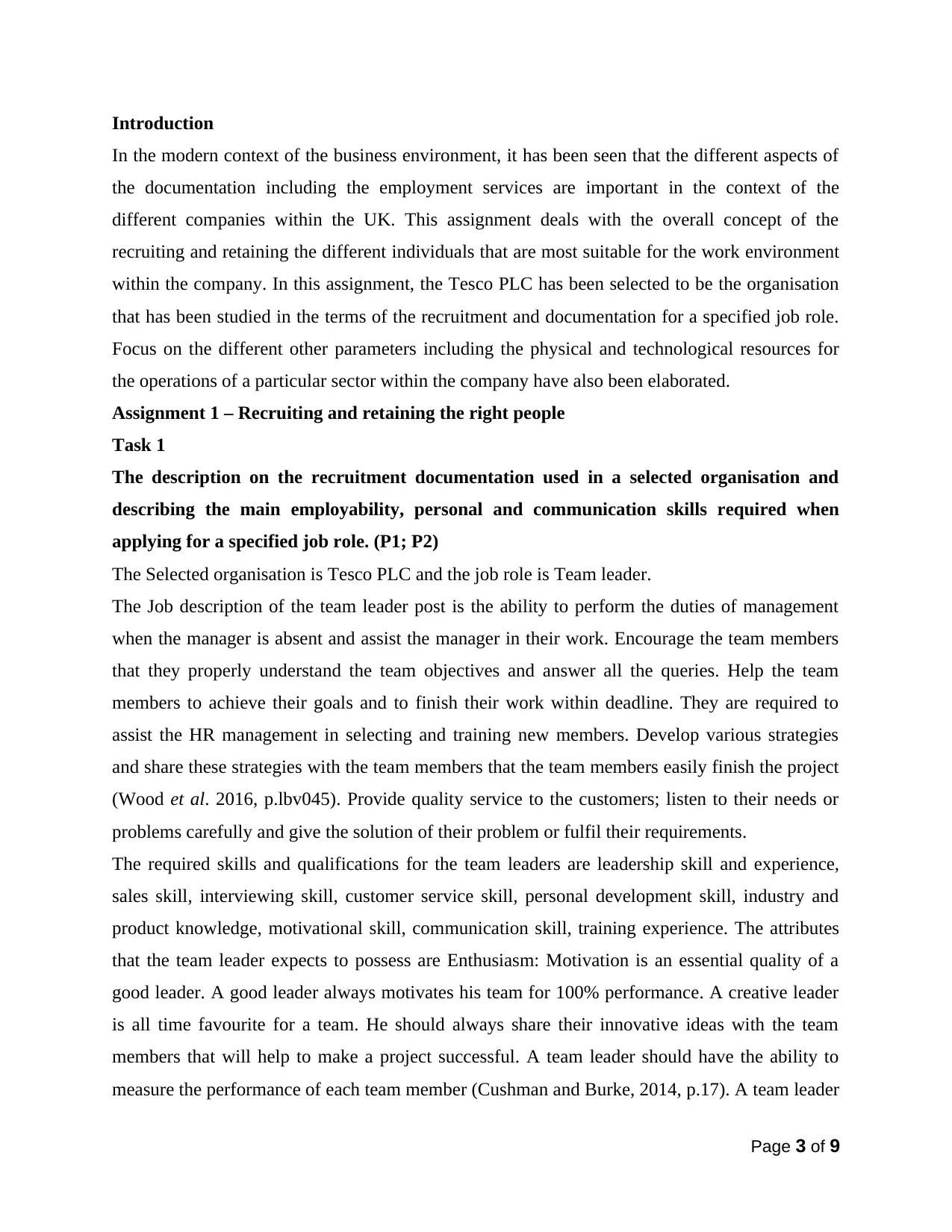
Introduction
In the modern context of the business environment, it has been seen that the different aspects of
the documentation including the employment services are important in the context of the
different companies within the UK. This assignment deals with the overall concept of the
recruiting and retaining the different individuals that are most suitable for the work environment
within the company. In this assignment, the Tesco PLC has been selected to be the organisation
that has been studied in the terms of the recruitment and documentation for a specified job role.
Focus on the different other parameters including the physical and technological resources for
the operations of a particular sector within the company have also been elaborated.
Assignment 1 – Recruiting and retaining the right people
Task 1
The description on the recruitment documentation used in a selected organisation and
describing the main employability, personal and communication skills required when
applying for a specified job role. (P1; P2)
The Selected organisation is Tesco PLC and the job role is Team leader.
The Job description of the team leader post is the ability to perform the duties of management
when the manager is absent and assist the manager in their work. Encourage the team members
that they properly understand the team objectives and answer all the queries. Help the team
members to achieve their goals and to finish their work within deadline. They are required to
assist the HR management in selecting and training new members. Develop various strategies
and share these strategies with the team members that the team members easily finish the project
(Wood et al. 2016, p.lbv045). Provide quality service to the customers; listen to their needs or
problems carefully and give the solution of their problem or fulfil their requirements.
The required skills and qualifications for the team leaders are leadership skill and experience,
sales skill, interviewing skill, customer service skill, personal development skill, industry and
product knowledge, motivational skill, communication skill, training experience. The attributes
that the team leader expects to possess are Enthusiasm: Motivation is an essential quality of a
good leader. A good leader always motivates his team for 100% performance. A creative leader
is all time favourite for a team. He should always share their innovative ideas with the team
members that will help to make a project successful. A team leader should have the ability to
measure the performance of each team member (Cushman and Burke, 2014, p.17). A team leader
Page 3 of 9
In the modern context of the business environment, it has been seen that the different aspects of
the documentation including the employment services are important in the context of the
different companies within the UK. This assignment deals with the overall concept of the
recruiting and retaining the different individuals that are most suitable for the work environment
within the company. In this assignment, the Tesco PLC has been selected to be the organisation
that has been studied in the terms of the recruitment and documentation for a specified job role.
Focus on the different other parameters including the physical and technological resources for
the operations of a particular sector within the company have also been elaborated.
Assignment 1 – Recruiting and retaining the right people
Task 1
The description on the recruitment documentation used in a selected organisation and
describing the main employability, personal and communication skills required when
applying for a specified job role. (P1; P2)
The Selected organisation is Tesco PLC and the job role is Team leader.
The Job description of the team leader post is the ability to perform the duties of management
when the manager is absent and assist the manager in their work. Encourage the team members
that they properly understand the team objectives and answer all the queries. Help the team
members to achieve their goals and to finish their work within deadline. They are required to
assist the HR management in selecting and training new members. Develop various strategies
and share these strategies with the team members that the team members easily finish the project
(Wood et al. 2016, p.lbv045). Provide quality service to the customers; listen to their needs or
problems carefully and give the solution of their problem or fulfil their requirements.
The required skills and qualifications for the team leaders are leadership skill and experience,
sales skill, interviewing skill, customer service skill, personal development skill, industry and
product knowledge, motivational skill, communication skill, training experience. The attributes
that the team leader expects to possess are Enthusiasm: Motivation is an essential quality of a
good leader. A good leader always motivates his team for 100% performance. A creative leader
is all time favourite for a team. He should always share their innovative ideas with the team
members that will help to make a project successful. A team leader should have the ability to
measure the performance of each team member (Cushman and Burke, 2014, p.17). A team leader
Page 3 of 9
⊘ This is a preview!⊘
Do you want full access?
Subscribe today to unlock all pages.

Trusted by 1+ million students worldwide
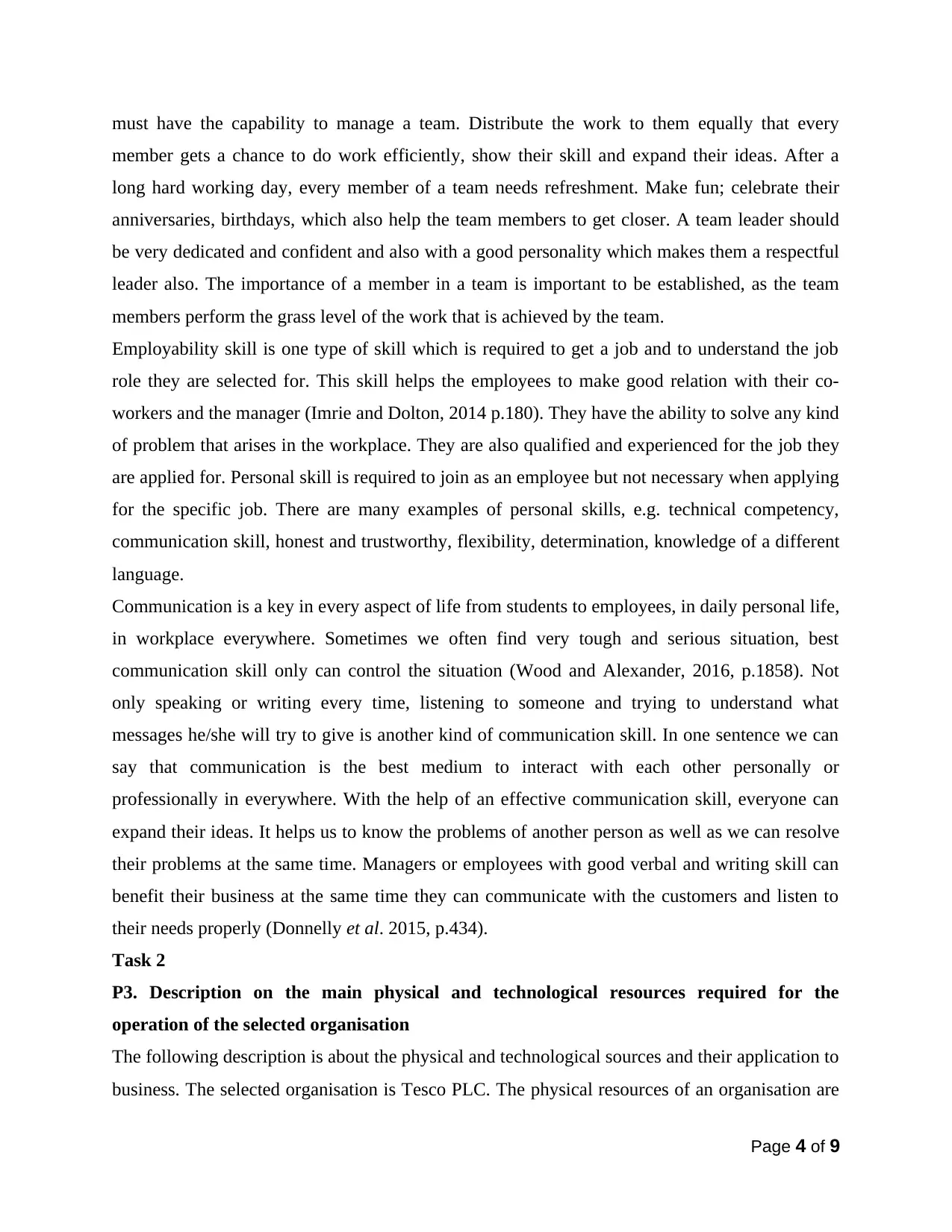
must have the capability to manage a team. Distribute the work to them equally that every
member gets a chance to do work efficiently, show their skill and expand their ideas. After a
long hard working day, every member of a team needs refreshment. Make fun; celebrate their
anniversaries, birthdays, which also help the team members to get closer. A team leader should
be very dedicated and confident and also with a good personality which makes them a respectful
leader also. The importance of a member in a team is important to be established, as the team
members perform the grass level of the work that is achieved by the team.
Employability skill is one type of skill which is required to get a job and to understand the job
role they are selected for. This skill helps the employees to make good relation with their co-
workers and the manager (Imrie and Dolton, 2014 p.180). They have the ability to solve any kind
of problem that arises in the workplace. They are also qualified and experienced for the job they
are applied for. Personal skill is required to join as an employee but not necessary when applying
for the specific job. There are many examples of personal skills, e.g. technical competency,
communication skill, honest and trustworthy, flexibility, determination, knowledge of a different
language.
Communication is a key in every aspect of life from students to employees, in daily personal life,
in workplace everywhere. Sometimes we often find very tough and serious situation, best
communication skill only can control the situation (Wood and Alexander, 2016, p.1858). Not
only speaking or writing every time, listening to someone and trying to understand what
messages he/she will try to give is another kind of communication skill. In one sentence we can
say that communication is the best medium to interact with each other personally or
professionally in everywhere. With the help of an effective communication skill, everyone can
expand their ideas. It helps us to know the problems of another person as well as we can resolve
their problems at the same time. Managers or employees with good verbal and writing skill can
benefit their business at the same time they can communicate with the customers and listen to
their needs properly (Donnelly et al. 2015, p.434).
Task 2
P3. Description on the main physical and technological resources required for the
operation of the selected organisation
The following description is about the physical and technological sources and their application to
business. The selected organisation is Tesco PLC. The physical resources of an organisation are
Page 4 of 9
member gets a chance to do work efficiently, show their skill and expand their ideas. After a
long hard working day, every member of a team needs refreshment. Make fun; celebrate their
anniversaries, birthdays, which also help the team members to get closer. A team leader should
be very dedicated and confident and also with a good personality which makes them a respectful
leader also. The importance of a member in a team is important to be established, as the team
members perform the grass level of the work that is achieved by the team.
Employability skill is one type of skill which is required to get a job and to understand the job
role they are selected for. This skill helps the employees to make good relation with their co-
workers and the manager (Imrie and Dolton, 2014 p.180). They have the ability to solve any kind
of problem that arises in the workplace. They are also qualified and experienced for the job they
are applied for. Personal skill is required to join as an employee but not necessary when applying
for the specific job. There are many examples of personal skills, e.g. technical competency,
communication skill, honest and trustworthy, flexibility, determination, knowledge of a different
language.
Communication is a key in every aspect of life from students to employees, in daily personal life,
in workplace everywhere. Sometimes we often find very tough and serious situation, best
communication skill only can control the situation (Wood and Alexander, 2016, p.1858). Not
only speaking or writing every time, listening to someone and trying to understand what
messages he/she will try to give is another kind of communication skill. In one sentence we can
say that communication is the best medium to interact with each other personally or
professionally in everywhere. With the help of an effective communication skill, everyone can
expand their ideas. It helps us to know the problems of another person as well as we can resolve
their problems at the same time. Managers or employees with good verbal and writing skill can
benefit their business at the same time they can communicate with the customers and listen to
their needs properly (Donnelly et al. 2015, p.434).
Task 2
P3. Description on the main physical and technological resources required for the
operation of the selected organisation
The following description is about the physical and technological sources and their application to
business. The selected organisation is Tesco PLC. The physical resources of an organisation are
Page 4 of 9
Paraphrase This Document
Need a fresh take? Get an instant paraphrase of this document with our AI Paraphraser
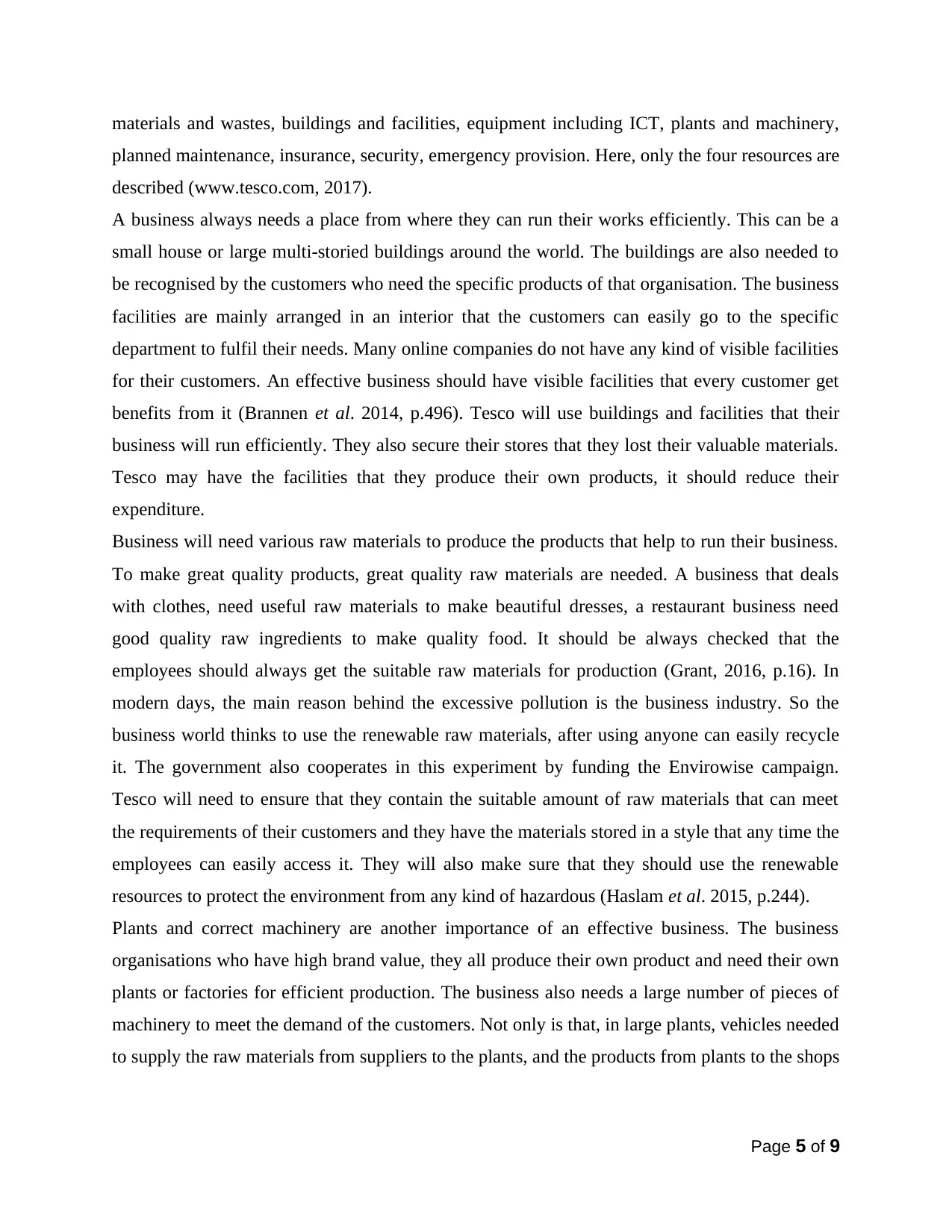
materials and wastes, buildings and facilities, equipment including ICT, plants and machinery,
planned maintenance, insurance, security, emergency provision. Here, only the four resources are
described (www.tesco.com, 2017).
A business always needs a place from where they can run their works efficiently. This can be a
small house or large multi-storied buildings around the world. The buildings are also needed to
be recognised by the customers who need the specific products of that organisation. The business
facilities are mainly arranged in an interior that the customers can easily go to the specific
department to fulfil their needs. Many online companies do not have any kind of visible facilities
for their customers. An effective business should have visible facilities that every customer get
benefits from it (Brannen et al. 2014, p.496). Tesco will use buildings and facilities that their
business will run efficiently. They also secure their stores that they lost their valuable materials.
Tesco may have the facilities that they produce their own products, it should reduce their
expenditure.
Business will need various raw materials to produce the products that help to run their business.
To make great quality products, great quality raw materials are needed. A business that deals
with clothes, need useful raw materials to make beautiful dresses, a restaurant business need
good quality raw ingredients to make quality food. It should be always checked that the
employees should always get the suitable raw materials for production (Grant, 2016, p.16). In
modern days, the main reason behind the excessive pollution is the business industry. So the
business world thinks to use the renewable raw materials, after using anyone can easily recycle
it. The government also cooperates in this experiment by funding the Envirowise campaign.
Tesco will need to ensure that they contain the suitable amount of raw materials that can meet
the requirements of their customers and they have the materials stored in a style that any time the
employees can easily access it. They will also make sure that they should use the renewable
resources to protect the environment from any kind of hazardous (Haslam et al. 2015, p.244).
Plants and correct machinery are another importance of an effective business. The business
organisations who have high brand value, they all produce their own product and need their own
plants or factories for efficient production. The business also needs a large number of pieces of
machinery to meet the demand of the customers. Not only is that, in large plants, vehicles needed
to supply the raw materials from suppliers to the plants, and the products from plants to the shops
Page 5 of 9
planned maintenance, insurance, security, emergency provision. Here, only the four resources are
described (www.tesco.com, 2017).
A business always needs a place from where they can run their works efficiently. This can be a
small house or large multi-storied buildings around the world. The buildings are also needed to
be recognised by the customers who need the specific products of that organisation. The business
facilities are mainly arranged in an interior that the customers can easily go to the specific
department to fulfil their needs. Many online companies do not have any kind of visible facilities
for their customers. An effective business should have visible facilities that every customer get
benefits from it (Brannen et al. 2014, p.496). Tesco will use buildings and facilities that their
business will run efficiently. They also secure their stores that they lost their valuable materials.
Tesco may have the facilities that they produce their own products, it should reduce their
expenditure.
Business will need various raw materials to produce the products that help to run their business.
To make great quality products, great quality raw materials are needed. A business that deals
with clothes, need useful raw materials to make beautiful dresses, a restaurant business need
good quality raw ingredients to make quality food. It should be always checked that the
employees should always get the suitable raw materials for production (Grant, 2016, p.16). In
modern days, the main reason behind the excessive pollution is the business industry. So the
business world thinks to use the renewable raw materials, after using anyone can easily recycle
it. The government also cooperates in this experiment by funding the Envirowise campaign.
Tesco will need to ensure that they contain the suitable amount of raw materials that can meet
the requirements of their customers and they have the materials stored in a style that any time the
employees can easily access it. They will also make sure that they should use the renewable
resources to protect the environment from any kind of hazardous (Haslam et al. 2015, p.244).
Plants and correct machinery are another importance of an effective business. The business
organisations who have high brand value, they all produce their own product and need their own
plants or factories for efficient production. The business also needs a large number of pieces of
machinery to meet the demand of the customers. Not only is that, in large plants, vehicles needed
to supply the raw materials from suppliers to the plants, and the products from plants to the shops
Page 5 of 9

in various locations. Tesco will need to ensure that they have the products and they have the
proper machinery (Karim et al. 2015, p.85).
Proper equipment is also one of the main factors to run a high demanding business. In modern
days, Information and Communication Technology (ICT) is one kind of most usable equipment
that can easily link various departments of business at a time. Tesco may use these technological
resources to fill the communication gap between the business worlds. The technological
resources are accumulated experience and skills, intellectual property, software licenses,
protection via patents and copyright (Adewuyi, 2016, p.45). The intellectual property is a skill to
expand your own ideas, make sure that everyone should listen to your ideas carefully and use
these ideas to improve the business. Generally, the experienced people share their ideas with
fresher and give training for their future. Tesco will follow this idea to improve their business.
Task 3
P4. The range of internal and external sources of finance available to the selected business
The internal sources of finance are Working capitals are the small amount of money which is
saved for small requirements like paying bills, rents, salaries etc. Retained profit is the amount of
money which is gotten as a profit from a business. Personal savings is mainly saved by owners
for their personal requirements. Sales of assets are the fixed assets that are required for any
future use. The external factors are the loans, shares, factoring, hire purchase, overdrafts, grants,
credits from suppliers etc (Karim et al. 2015, p.86).
Page 6 of 9
proper machinery (Karim et al. 2015, p.85).
Proper equipment is also one of the main factors to run a high demanding business. In modern
days, Information and Communication Technology (ICT) is one kind of most usable equipment
that can easily link various departments of business at a time. Tesco may use these technological
resources to fill the communication gap between the business worlds. The technological
resources are accumulated experience and skills, intellectual property, software licenses,
protection via patents and copyright (Adewuyi, 2016, p.45). The intellectual property is a skill to
expand your own ideas, make sure that everyone should listen to your ideas carefully and use
these ideas to improve the business. Generally, the experienced people share their ideas with
fresher and give training for their future. Tesco will follow this idea to improve their business.
Task 3
P4. The range of internal and external sources of finance available to the selected business
The internal sources of finance are Working capitals are the small amount of money which is
saved for small requirements like paying bills, rents, salaries etc. Retained profit is the amount of
money which is gotten as a profit from a business. Personal savings is mainly saved by owners
for their personal requirements. Sales of assets are the fixed assets that are required for any
future use. The external factors are the loans, shares, factoring, hire purchase, overdrafts, grants,
credits from suppliers etc (Karim et al. 2015, p.86).
Page 6 of 9
⊘ This is a preview!⊘
Do you want full access?
Subscribe today to unlock all pages.

Trusted by 1+ million students worldwide
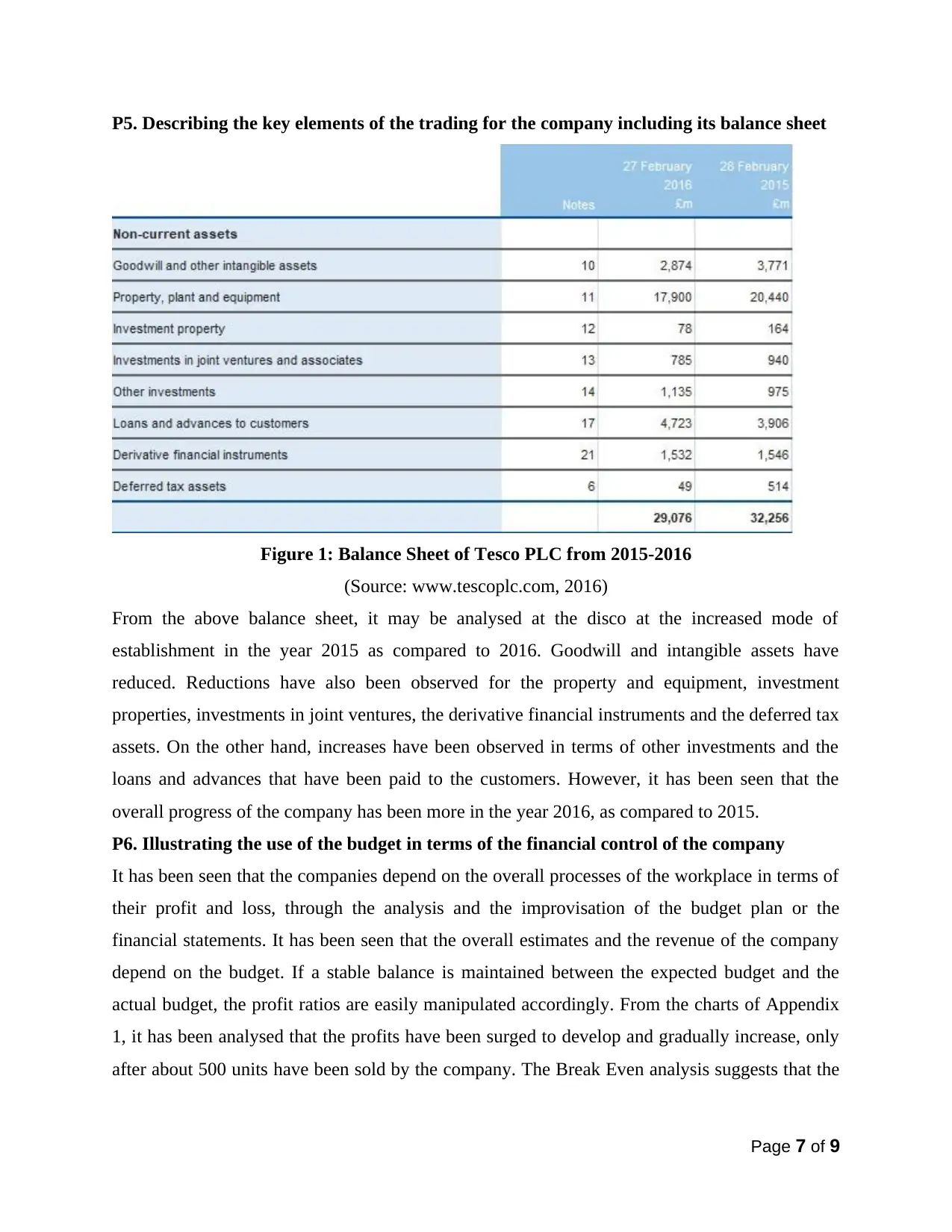
P5. Describing the key elements of the trading for the company including its balance sheet
Figure 1: Balance Sheet of Tesco PLC from 2015-2016
(Source: www.tescoplc.com, 2016)
From the above balance sheet, it may be analysed at the disco at the increased mode of
establishment in the year 2015 as compared to 2016. Goodwill and intangible assets have
reduced. Reductions have also been observed for the property and equipment, investment
properties, investments in joint ventures, the derivative financial instruments and the deferred tax
assets. On the other hand, increases have been observed in terms of other investments and the
loans and advances that have been paid to the customers. However, it has been seen that the
overall progress of the company has been more in the year 2016, as compared to 2015.
P6. Illustrating the use of the budget in terms of the financial control of the company
It has been seen that the companies depend on the overall processes of the workplace in terms of
their profit and loss, through the analysis and the improvisation of the budget plan or the
financial statements. It has been seen that the overall estimates and the revenue of the company
depend on the budget. If a stable balance is maintained between the expected budget and the
actual budget, the profit ratios are easily manipulated accordingly. From the charts of Appendix
1, it has been analysed that the profits have been surged to develop and gradually increase, only
after about 500 units have been sold by the company. The Break Even analysis suggests that the
Page 7 of 9
Figure 1: Balance Sheet of Tesco PLC from 2015-2016
(Source: www.tescoplc.com, 2016)
From the above balance sheet, it may be analysed at the disco at the increased mode of
establishment in the year 2015 as compared to 2016. Goodwill and intangible assets have
reduced. Reductions have also been observed for the property and equipment, investment
properties, investments in joint ventures, the derivative financial instruments and the deferred tax
assets. On the other hand, increases have been observed in terms of other investments and the
loans and advances that have been paid to the customers. However, it has been seen that the
overall progress of the company has been more in the year 2016, as compared to 2015.
P6. Illustrating the use of the budget in terms of the financial control of the company
It has been seen that the companies depend on the overall processes of the workplace in terms of
their profit and loss, through the analysis and the improvisation of the budget plan or the
financial statements. It has been seen that the overall estimates and the revenue of the company
depend on the budget. If a stable balance is maintained between the expected budget and the
actual budget, the profit ratios are easily manipulated accordingly. From the charts of Appendix
1, it has been analysed that the profits have been surged to develop and gradually increase, only
after about 500 units have been sold by the company. The Break Even analysis suggests that the
Page 7 of 9
Paraphrase This Document
Need a fresh take? Get an instant paraphrase of this document with our AI Paraphraser
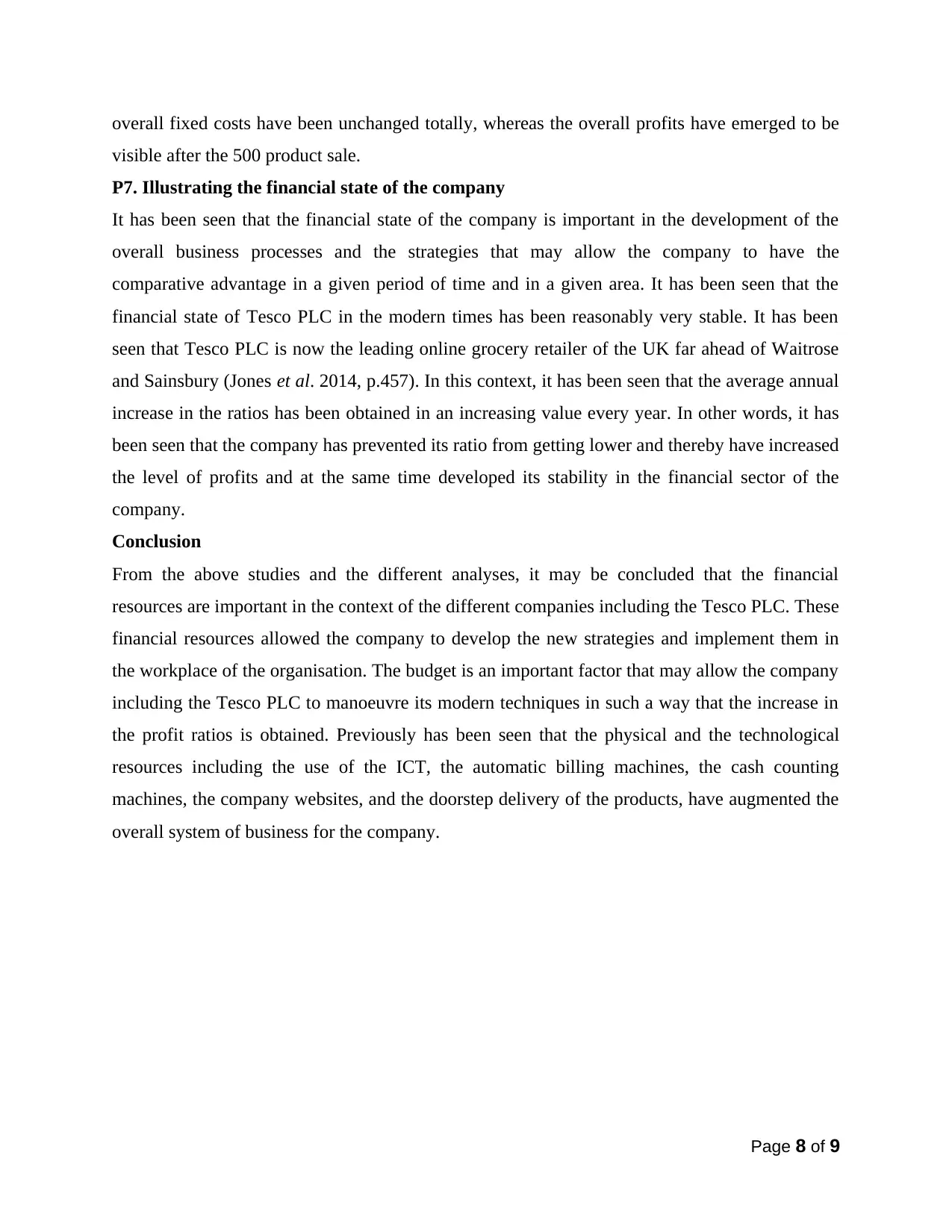
overall fixed costs have been unchanged totally, whereas the overall profits have emerged to be
visible after the 500 product sale.
P7. Illustrating the financial state of the company
It has been seen that the financial state of the company is important in the development of the
overall business processes and the strategies that may allow the company to have the
comparative advantage in a given period of time and in a given area. It has been seen that the
financial state of Tesco PLC in the modern times has been reasonably very stable. It has been
seen that Tesco PLC is now the leading online grocery retailer of the UK far ahead of Waitrose
and Sainsbury (Jones et al. 2014, p.457). In this context, it has been seen that the average annual
increase in the ratios has been obtained in an increasing value every year. In other words, it has
been seen that the company has prevented its ratio from getting lower and thereby have increased
the level of profits and at the same time developed its stability in the financial sector of the
company.
Conclusion
From the above studies and the different analyses, it may be concluded that the financial
resources are important in the context of the different companies including the Tesco PLC. These
financial resources allowed the company to develop the new strategies and implement them in
the workplace of the organisation. The budget is an important factor that may allow the company
including the Tesco PLC to manoeuvre its modern techniques in such a way that the increase in
the profit ratios is obtained. Previously has been seen that the physical and the technological
resources including the use of the ICT, the automatic billing machines, the cash counting
machines, the company websites, and the doorstep delivery of the products, have augmented the
overall system of business for the company.
Page 8 of 9
visible after the 500 product sale.
P7. Illustrating the financial state of the company
It has been seen that the financial state of the company is important in the development of the
overall business processes and the strategies that may allow the company to have the
comparative advantage in a given period of time and in a given area. It has been seen that the
financial state of Tesco PLC in the modern times has been reasonably very stable. It has been
seen that Tesco PLC is now the leading online grocery retailer of the UK far ahead of Waitrose
and Sainsbury (Jones et al. 2014, p.457). In this context, it has been seen that the average annual
increase in the ratios has been obtained in an increasing value every year. In other words, it has
been seen that the company has prevented its ratio from getting lower and thereby have increased
the level of profits and at the same time developed its stability in the financial sector of the
company.
Conclusion
From the above studies and the different analyses, it may be concluded that the financial
resources are important in the context of the different companies including the Tesco PLC. These
financial resources allowed the company to develop the new strategies and implement them in
the workplace of the organisation. The budget is an important factor that may allow the company
including the Tesco PLC to manoeuvre its modern techniques in such a way that the increase in
the profit ratios is obtained. Previously has been seen that the physical and the technological
resources including the use of the ICT, the automatic billing machines, the cash counting
machines, the company websites, and the doorstep delivery of the products, have augmented the
overall system of business for the company.
Page 8 of 9
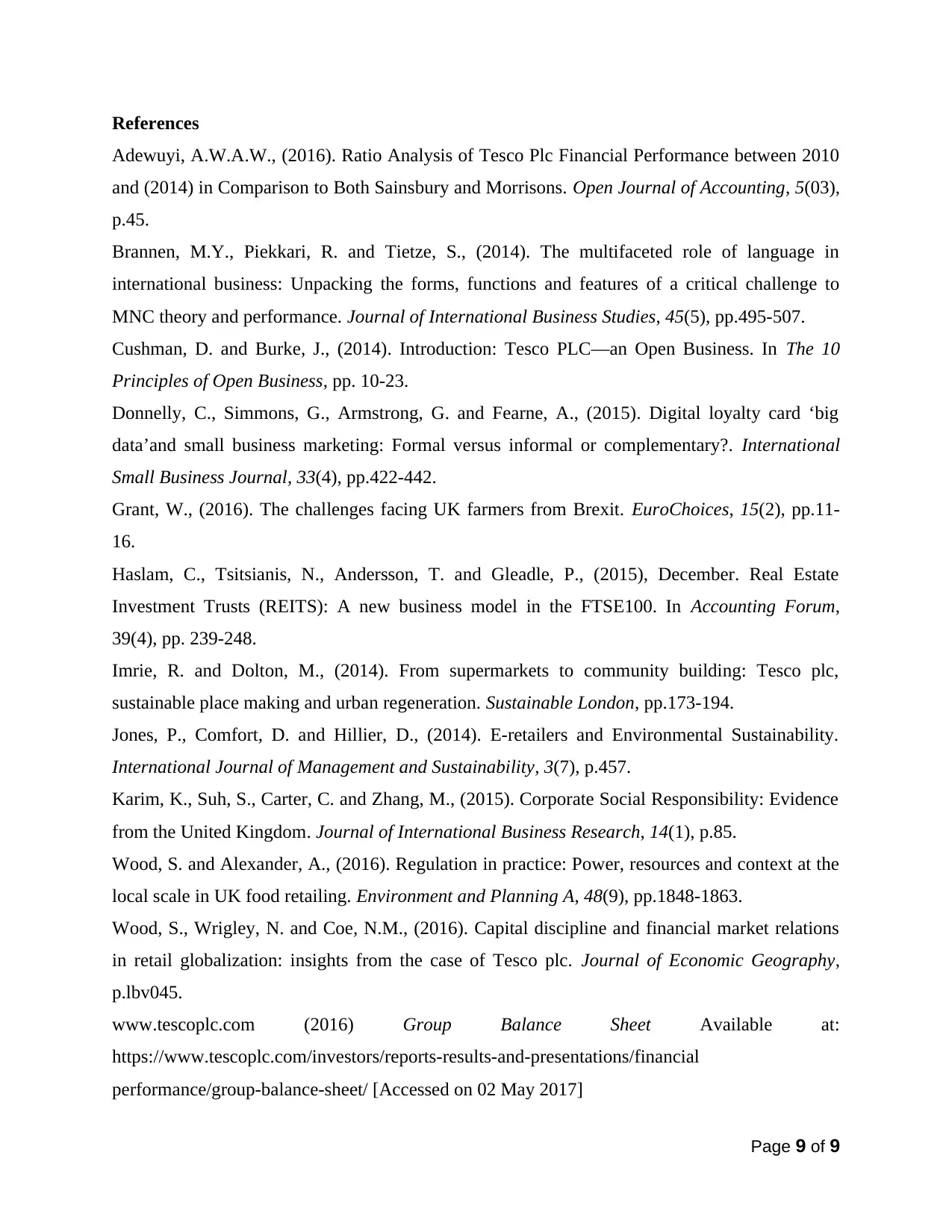
References
Adewuyi, A.W.A.W., (2016). Ratio Analysis of Tesco Plc Financial Performance between 2010
and (2014) in Comparison to Both Sainsbury and Morrisons. Open Journal of Accounting, 5(03),
p.45.
Brannen, M.Y., Piekkari, R. and Tietze, S., (2014). The multifaceted role of language in
international business: Unpacking the forms, functions and features of a critical challenge to
MNC theory and performance. Journal of International Business Studies, 45(5), pp.495-507.
Cushman, D. and Burke, J., (2014). Introduction: Tesco PLC—an Open Business. In The 10
Principles of Open Business, pp. 10-23.
Donnelly, C., Simmons, G., Armstrong, G. and Fearne, A., (2015). Digital loyalty card ‘big
data’and small business marketing: Formal versus informal or complementary?. International
Small Business Journal, 33(4), pp.422-442.
Grant, W., (2016). The challenges facing UK farmers from Brexit. EuroChoices, 15(2), pp.11-
16.
Haslam, C., Tsitsianis, N., Andersson, T. and Gleadle, P., (2015), December. Real Estate
Investment Trusts (REITS): A new business model in the FTSE100. In Accounting Forum,
39(4), pp. 239-248.
Imrie, R. and Dolton, M., (2014). From supermarkets to community building: Tesco plc,
sustainable place making and urban regeneration. Sustainable London, pp.173-194.
Jones, P., Comfort, D. and Hillier, D., (2014). E-retailers and Environmental Sustainability.
International Journal of Management and Sustainability, 3(7), p.457.
Karim, K., Suh, S., Carter, C. and Zhang, M., (2015). Corporate Social Responsibility: Evidence
from the United Kingdom. Journal of International Business Research, 14(1), p.85.
Wood, S. and Alexander, A., (2016). Regulation in practice: Power, resources and context at the
local scale in UK food retailing. Environment and Planning A, 48(9), pp.1848-1863.
Wood, S., Wrigley, N. and Coe, N.M., (2016). Capital discipline and financial market relations
in retail globalization: insights from the case of Tesco plc. Journal of Economic Geography,
p.lbv045.
www.tescoplc.com (2016) Group Balance Sheet Available at:
https://www.tescoplc.com/investors/reports-results-and-presentations/financial
performance/group-balance-sheet/ [Accessed on 02 May 2017]
Page 9 of 9
Adewuyi, A.W.A.W., (2016). Ratio Analysis of Tesco Plc Financial Performance between 2010
and (2014) in Comparison to Both Sainsbury and Morrisons. Open Journal of Accounting, 5(03),
p.45.
Brannen, M.Y., Piekkari, R. and Tietze, S., (2014). The multifaceted role of language in
international business: Unpacking the forms, functions and features of a critical challenge to
MNC theory and performance. Journal of International Business Studies, 45(5), pp.495-507.
Cushman, D. and Burke, J., (2014). Introduction: Tesco PLC—an Open Business. In The 10
Principles of Open Business, pp. 10-23.
Donnelly, C., Simmons, G., Armstrong, G. and Fearne, A., (2015). Digital loyalty card ‘big
data’and small business marketing: Formal versus informal or complementary?. International
Small Business Journal, 33(4), pp.422-442.
Grant, W., (2016). The challenges facing UK farmers from Brexit. EuroChoices, 15(2), pp.11-
16.
Haslam, C., Tsitsianis, N., Andersson, T. and Gleadle, P., (2015), December. Real Estate
Investment Trusts (REITS): A new business model in the FTSE100. In Accounting Forum,
39(4), pp. 239-248.
Imrie, R. and Dolton, M., (2014). From supermarkets to community building: Tesco plc,
sustainable place making and urban regeneration. Sustainable London, pp.173-194.
Jones, P., Comfort, D. and Hillier, D., (2014). E-retailers and Environmental Sustainability.
International Journal of Management and Sustainability, 3(7), p.457.
Karim, K., Suh, S., Carter, C. and Zhang, M., (2015). Corporate Social Responsibility: Evidence
from the United Kingdom. Journal of International Business Research, 14(1), p.85.
Wood, S. and Alexander, A., (2016). Regulation in practice: Power, resources and context at the
local scale in UK food retailing. Environment and Planning A, 48(9), pp.1848-1863.
Wood, S., Wrigley, N. and Coe, N.M., (2016). Capital discipline and financial market relations
in retail globalization: insights from the case of Tesco plc. Journal of Economic Geography,
p.lbv045.
www.tescoplc.com (2016) Group Balance Sheet Available at:
https://www.tescoplc.com/investors/reports-results-and-presentations/financial
performance/group-balance-sheet/ [Accessed on 02 May 2017]
Page 9 of 9
⊘ This is a preview!⊘
Do you want full access?
Subscribe today to unlock all pages.

Trusted by 1+ million students worldwide
1 out of 9
Related Documents
Your All-in-One AI-Powered Toolkit for Academic Success.
+13062052269
info@desklib.com
Available 24*7 on WhatsApp / Email
![[object Object]](/_next/static/media/star-bottom.7253800d.svg)
Unlock your academic potential
Copyright © 2020–2025 A2Z Services. All Rights Reserved. Developed and managed by ZUCOL.




